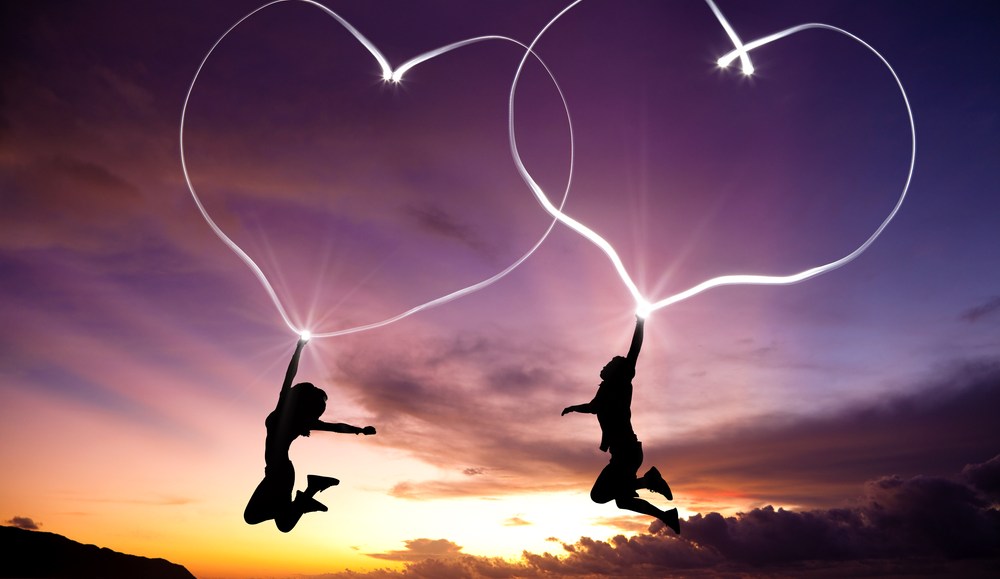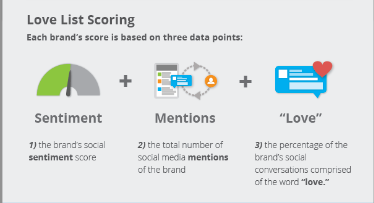Save 50% on a 3-month Digiday+ membership. Ends Dec 12.

Since the dawn of romantic love, couples have struggled to quantify their feelings for each other. “I love you,” says he. “I love you more,” she replies.
Now a new tool purports to tell brands just how adored they really are by their fans online. “Likes” and at-mentions are nice, but social media management platform Hootsuite today unveiled its inaugural “Love List,” which aims to quantify — and rank — customer sentiment.
 The Love List report ranks more than 450 of the world’s top brands on the amount of love they are seeing on social media. It will be updated monthly using three key data points: the total number of brand mentions received across over 25 platforms, the sentiment score for the particular brand — whether the mentions are positive or negative — and the percentage of social conversations about the brand containing the word “love” over a month.
The Love List report ranks more than 450 of the world’s top brands on the amount of love they are seeing on social media. It will be updated monthly using three key data points: the total number of brand mentions received across over 25 platforms, the sentiment score for the particular brand — whether the mentions are positive or negative — and the percentage of social conversations about the brand containing the word “love” over a month.
“The ‘Love List’ is unique because it’s the first of its kind that uses analysis rather than simply tallying the number of likes and shares brands get on their social channels and goes a couple of layers deeper,” said Mark Pascarella, General Manager of Hootsuite uberVU, the analytics tool that compiles the list at Hootsuite. “Too many brands still focus on broadcasting rather than listening, and we are getting them the data they need to listen.”
Data is collected from the usual social media suspects. But beyond Facebook, Twitter and other popular platforms, it also measures how the brands are faring in online press mentions from The New York Times, CNN and others, as well as on forgotten forums like Flickr.
The results are illuminating: Some of the most-loved brands so far include Kohl’s, Twitter, The CW Network, Nordstorm and Dove — which tops the list with a score of 99.6. Hootsuite attributes this to its successful leveraging of its “Real Beauty” campaign on social media, which has generated significant engagement among its fans.
“The preponderance of brands like Dove suggests that people are interested in brands that are accessible to them — a trend we’ve seen throughout the list,” Pascarella said. “Brands that have cultivated a passionate fan base, that have an invested group of outspoken fans and that have engaged in inspiring and amusing campaigns and takeaways have taken the cake.”
The fact that the list will be updated monthly not only lets brands track and improve their performance but also provides perspectives on broader industry trends over time. The first list, for example, reveals that the food and beverage segment is home to some of the most-loved brands, whereas the luxury industry is struggling on social media. Only one brand — Chanel — made it to the top 25.
The “Love List” hasn’t been around long enough yet for brands to show it some love in return, but Hootsuite hopes it will encourage them to quantify brand perception beyond the social media sphere.
“We wanted to pull in a metric that can be adopted across all the branches of a company,” Pascarella said. “Everything from sales team to the product development team impacts a brand’s perception, not just the social media team.”
More in Marketing

In Graphic Detail: Here’s what the creator economy is expected to look like in 2026
Digiday has charted its expected revenue, key platforms for creator content as well as what types of creators brands want to work with.

Ulta, Best Buy and Adidas dominate AI holiday shopping mentions
The brands that are seeing the biggest boost from this shift in consumer behavior are some of the biggest retailers.

Future of Marketing Briefing: AI confuses marketers but their own uncertainty runs deeper
That was the undercurrent at this week’s Digiday Programmatic Marketing Summit in New Orleans.





